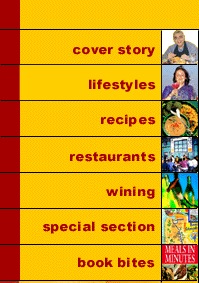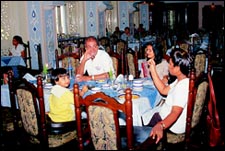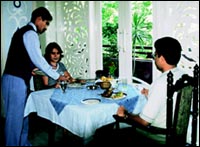


 Prawn Sukem and Pork Vindaloo at Riorico
Prawn Sukem and Pork Vindaloo at Riorico
|
|
If you are planning a holiday in Goa, here�s what you do. Stay at the Mandovi, Panaji�s heritage hotel, overlooking the busy capital, its port station, the Palacio (secretariat) next door, the river, the ferries going across, Betim on the opposite bank. It is a convenient address, there are restaurants and tavernas all around, including the Madhav Ashram directly behind the Mandovi for fiery Hindu-Goan food (once you eat the Hindu-Goan food, you may forget the Catholic-Goan), and taxis and motor-bikes below the hotel to carry you to food destinations across the state. Or, best of all, you may dine every day at Riorico, the stately dining room on the first floor of the Mandovi, serving the most authentic Portuguese-Goan food between Porvorim and Lisboa.
It is an impressive dining room, with oak tables and chairs precisely laid out, four chandeliers, and customers talking in hushed tones so that they do not disturb the orchestra. It is old fashioned and classy, the kind of place that will feed you well and without fuss. Old Goa with old money feeds here, not so much the tourists, the Dempos, the Salgaonkars, the Chougules, they come with their families. Whether I am in Goa for a day or a week, I always have at least one meal here, and I always order more or less the same things. A caldo verde, a clear soup of potatoes, with local spinach, flavoured with garlic. A dry prawn sukem, though made with fresh prawns in grated coconut, curry pattas and onions, to be lifted in the spoons and put in the mouth in between the main food. And either a pork vindaloo or a prawn balchao.
They make a vindaloo from fish also, but the authentic one is pork. And if you don�t eat pork, for whatever reasons, then don�t order the vindaloo. It is made with red masala, what they call recheado, the masalas ground in toddy vindaloo, providing Goan kitchens that particular aroma. The pork itself is boneless, in cubes, and much of the fat from the rind of the meat is peeled off, though happily not all. It is when the pork is sauted and cooked in the red masalas that the rind turns crisp. Plunge a form into it, then put it in the mouth, the rind is crisp, the fat underneath it yielding, and the meat further down tender and juicy. Pork meat is the tenderest in the world, and it comes in blocks, not stringy. The toddy provides the sharpness to the meat and the gravy. And it is a no-nonsense dish, no addition of vegetables and things. At the Riorico they give you the Goan bread, poi, to eat it with. The coarse wheat dough of the poi is fermented with toddy overnight. If you are not going to Goa, and live in Bombay, I suggest you go to the late Sacru Menezes�s City Kitchen at Fort Market. The pork vindaloo here is as good, it has more gravy, and they don�t trim the fat. Have it with parboiled rice.
The prawn balchao is best only at the Riorico. It is both a pickle and a preserve, I eat it as a preserve. And it can be made with both fresh and dry prawns, at the restaurant they use fresh prawns, and flavour it with a powder of dry prawns. The masala for the balchao is peri-peri, a red masala with toddy vinegar and not a drop of water. And it is the absence of water that makes it stay for a fortnight - more. The prawns used are small, and they are sauted in the masala of tomatoes, chillis, garlic till the whole dish is thick. It tastes like a pickle, a cross between a Navsari Parsi pickle and a Hyderabadi fish pickle.
A word about the cook, he is Alphonso Pereira, a graduate of the Goa Catering Institute, who has roamed the world and come back. He has worked at the Taj, at the Zodiac and Rendezvous, and at the Aguada and Village, and he has worked on board QE2, going round the world three times. His wife is Janice Pereira, also an alumni of the Goa institute, and an all-India gold medallist student chef. She now teaches at the institute.
The Mandovi�s fish curry and rice, either with pomfret or surmai, is something to die for, he tells me. I agree. Contrary to general belief, no vinegar is used, that goes only with the red masalas. Instead, they finish with dry kokum skins, nice and sour. I could go on, and touching only the Goan dishes, the cafreals, caldeiradas, xacutis, the prawns stuffed in papads. But I shall leave these to the diner to explore. A word of advice though, order the bread basket, the freshest bread outside Irani and Malayali bakeries. The basket contains, besides the poi, a bread called katri (slice), made with refined flour and cut in the centre to let out the fermentation; kankan, which is bread that is bangle-shaped and very crisp; and urdo, like a crescent. A word about the desserts. The Mandovi crepe, freshly grated coconut, toddy, jaggery, served with chocolate sauce and cashewnuts. And the signature bebinca, layer upon layer upon layer of milk, coconut, egg, sugar, flour, butter. After that, take the elevator downstairs to the road, or upstairs to the room, if you are staying at the Mandovi.
|

Home Page
About the mag
Subscribe
Advertise
Contact Us
